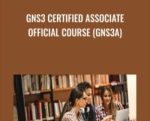This is the official GNS3 Certified Associate course. This course covers the topics you need to know to pass the GNS3CA Exam.The GNS3 Certified Associate (GNS3A) program is a multi-vendor, next generation network engineer certification that focuses on the core skills that network engineers need today for the new era of rapidly changing, programmable, automated and intelligent networks.In today’s rapidly changing networking environment where billions of IoT devices are being added to the Internet every year, it is no longer enough for network engineers to simply configure network devices manually via a Command Line Interface (CLI). Network engineer skill-sets need to diversify to include network programmability and automation skills such as Ansible and Python, programmable APIs, Open Networking technologies, virtualization, Linux and support of multi-vendor environments.The GNS3A program will prepare you to have the knowledge and training to:Install and build virtual networks using GNS3 with knowledge of multiple vendors and protocolsExplain and describe GNS3 core functions and architectureIdentify and troubleshoot GNS3 installation and configuration issuesProgram networks using Python network automation scriptsImplement OpenFlow based SDN networks within GNS3 topologiesImplement Docker based appliances within GNS3 topologiesDescribe DevOps terms such as Data Formats, APIs, REST, NETCONF and othersProgram networks using Ansible network automation scriptsInstall and configure Linux based virtual machines and core Linux functionsInstall, configure and troubleshoot hypervisors such as VMware Workstation, ESXi, QEMU and VirtualBoxTroubleshoot basic network issuesExam topics:Core GNS3 SkillsExplain GNS3 architecture:GNS3 GUIGNS3 VMLocal versus remote VMsSchema (GUI / Web / Controller / Compute / Emulators)Explain, configure and troubleshoot GNS3 Hypervisor optionsVMware Workstation ProVMware Workstation PlayerVmware FusionVirtualBoxESXiQEMUDescribe GNS3 cloud solutions:Packet.netExplain and contrast GNS3 device supportSwitchesRoutersFirewallsServersHostsExplain, configure and troubleshoot device types:Built-inHubSwitchCloud optionsNetwork VendorsDynamips IOS routersCisco IOSv applianceCisco IOSvL2 applianceArista vEOS applianceJuniper SRXv applianceFRRouting applianceServer / PC appliancesUbuntu ApplianceNetwork Automation ApplianceNetworker’s Toolkit ApplianceDNS applianceOther popular GNS3 appliancesTroubleshoot GNS3 installation issues (GUI and VM)Describe GNS3 best practicesGNS3 GUIGNS3 VMEmulation optionsVendor device emulation / simulation optionsDescribe and use GNS3 programmability optionsREST APIcURLPostmanPython scriptsBash scriptsPython:Describe Python terms including:ObjectsVariablesStringsIntegers and floatsBooleansOperatorsListsDictionariesTuplesLoopsConditionsFunctionsExplain and troubleshoot Python code snippets includingText manipulation (split / join / concatenation)Loops (for / while)If / else / elseif logicDescribe and verify the Python Telnet library for network device automationDescribe, verify and troubleshoot the use of Netmiko for network device automationDescribe, verify and troubleshoot the use of NAPALM for network device automationLinuxDescribe Linux distributions (Red Hat, CentOS, Fedora, Debian, Ubuntu, Mint)Describe Linux Text editors (vi, nano)Configure, verify and troubleshoot IPv6 addressing, default gateways and static routes (Ubuntu)Describe and verify Linux Directory structures (Ubuntu)Describe file copying, moving and deleting (Ubuntu)Describe and verify common Linux commands (ls, grep, more, cat, less) (Ubuntu)Describe and verify Linux Permissions (Ubuntu)Describe Linux Processes (Ubuntu)Configure and verify Linux software installation (Ubuntu)Configure and verify Linux DNS server (dnsmasq)Configure and verify Linux DNS server (dnsmasq)Configure and troubleshoot network devices such as Cumulus Linux, Arista, NX9000 and FRR using Linux commandSDNDescribe SDN terms and definitionsController functionsPlane separationNorthbound interface (APIs)Southbound interface (APIs)NFVDescribe and contrast SDN visionsOpen SDNSDN via OverlaysSDN via APIsAutomation based SDNDescribe SDN protocolsOpenFlowNETCONFVxLANYANGDescribe and contrast Data FormatsJSONXMLYAMLDescribe source control using GitDescribe APIsNetwork Device APIsREST APIsDescribe and contrast SDN controllers:Open source SDN controllers (OpenDaylight, ONOS, RYU)Vendor SDN controllers (NSX, ACI, APIC-EM)Describe and verify basic OpenFlow switch flows (OVS / Mininet)OpenFlow 1.0 and 1.3 onlyProactive vs Reactive flowsPipeline ProcessingMatch TypesMatch ActionsMessage typesOpenFlow PortsAutomation ToolsAnsibleInstall and configure Ansible for network automationDescribe and contrast agentless vs agent based automation toolsDescribe Ansible terms such as Idempotency, Ad Hoc changes, inventory files, plays, tasks and playbooksImplement and troubleshoot Ansible scripts for network device automationDescribe and contrast Salt, Puppet and ChefVirtualization technologiesDescribe and contrast hypervisorsVMware Workstation ProVMware Workstation PlayerVMWare FusionVirtualBoxQEMUESXiDescribe and contrast virtual image types (img, qcow2, iso, ova and vmdk)Explain virtualization concepts such as nested virtualization, host virtualization, network NIC virtualization, network device sizing and scaling.Install and configure GNS3 supported hypervisorsInstall and configure GNS3 with cloud based providers such as Packet.netGNS3 Academy CurriculumWelcomeOverview (12:16)GNS3 Exam Q&A (9:32)GNS3 Team Introduction (20:24)Jeremy Grossmann – creator of GNS3 – discusses the GNS3 architecture with David Bombal (22:05)MenuAnswering your questions (1:53)GNS3 Installation and configurationGNS3 2.1 Install Part 1- Components and software requirements (3:32)GNS3 2.1 Install Part 2- GUI install (11:47)GNS3 2.1 Install Part 3- Troubleshooting GNS3 installation issues Windows 10 (4:37)GNS3 2.1 Install Part 4- Basic GNS3 Network (your first network) (9:50)GNS3 2.1 Install Part 5- Where do I get Cisco IOS images (7:55)GNS3 2.1 Install Part 6- Cisco IOS network using Dynamips (12:13)GNS3 2.1 Install Part 7- GNS3 VM, VIRL and switching (8:29)GNS3 2.1 Install Part 8- GNS3 VM, VMware 14 issues (11:55)GNS3 2.1 Install Part 9- Cisco VIRL IOSv import into GNS3 (11:23)GNS3 2.1 Install Part 10- Cisco VIRL and Dynamips network (7:47)GNS3 installation in the cloudPacket.net and GNS3 (Part 1): Overview (4:35)Packet.net and GNS3 (Part 2): Documentation, Discounts and signup (5:10)Packet.net and GNS3 (Part 3): SSH Keys (Generate with PuttyGen) (4:21)Packet.net and GNS3 (Part 4): Deploy Server and setup VPN (8:56)Packet.net and GNS3 (Part 5): Integrate the GNS3 GUI with Packet.net (8:25)GNS3 installation on ESXiInstall GNS3 on VMware ESXi Part 1 (11:11)Install GNS3 on VMware ESXi Part 2 (9:45)GNS3 Installation: VMware PlayerPart 1: GNS3 & VMware Workstation Player (9:47)Part 2: GNS3 & VMware Workstation Player (12:15)GNS3 Preferences & VMware settingsGNS3 VM Preferences (5:10)GNS3 Installation on Mac OSInstall GNS3 on a Mac (with GNS3 VM) (12:28)Upgrading Docker Containers in GNS3Docker GNS3 Automation Container Upgrade (12:18)GNS3 2.X ArchitectureGNS3 2.0 Architecture and schema Part 1 What is the GNS3 Controller (6:51)GNS3 2.0 Architecture and schema Part 2 Emulators and virtualization (7:56)GNS3 Version 2.0 updatesUpgrade to version 2.0 (16:16)GNS3 2.0 Portable Projects – easily export and import GNS3 projects (3:47)GNS3 2.0 Profiles = multiple settings for different scenarios (3:46)GNS3 2.0 New Features Smart packet capture and capture on any link (4:07)GNS3 2.0 New Feature Support for color-blind users (2:02)GNS3 2.0 New Feature Connect IOSv, IOSvL2 and other Qemu devices while powered o (1:47)GNS3 2.0 New Feature Select where VPCS runs (2:27)GNS3 2.0 NAT Node (9:09)GNS3 Talks Fast IOSv boot (9:39)Mac OS with Windows 10 Virtual Machine = Mac+GNS3+GNS3 VM+Windows 10 VM+Cisc (7:51)GNS3 Talks Multiple clients sharing projects in real time, plus console sess (9:55)GNS3 2.1GNS3 2.1 Part 1: Introduction and packet filters (10:59)GNS3 2.1 Part 3: Node duplication (3:20)GNS3 2.1 Part 2: Appliance templates (6:57)GNS3 2.1 Part 4: Zoom percentage, 275 network adapters and more (5:13)GNS3 GUI Part 1 Workspace and othersGNS3 Workspace (1:45)GNS3 Topology Summary (1:24)Server Summary (0:33)GNS3 console (0:45)GNS3 Menu Overview (1:15)GNS3 GUI Part 2: ProjectsGNS3 Project Terminology (4:28)GNS3 Projects (3:12)GNS3 GUI GNS3 GUI Part 3: More GUI Options & demonstrationsInterface labels (0:33)Console connect to all devices (1:06)Start, suspend and stop routers – EIGRP convergence demostration (3:31)Pause Router Demo with EIGRP demonstration (2:04)Notes, Pictures, Zoom, Ellipses, Rectangles, Layers (2:35)GNS3 Styles (0:41)GNS3 REST APISoftware is eating the world and the GNS3 REST API: SDN, APIs, Network Programma (7:59)GNS3 REST API Part 2: SDN, APIs, Network Programmability (8:35)GNS3 REST API Part 3:Create a GNS3 project, add nodes, add links programmability (9:34)GNS3 REST API Part 4: Start GNS3 nodes, connect remotely without GUI (4:11)GNS3 REST API Part 5: cURL and bash scripting with the GNS3 REST API (11:07)VMware Questions and IssuesTroubleshooting Intel VTX Issues with VMware (6:55)VMware network adapter settings (5:29)GNS3 Questions: What can I do?GNS3 Questions: Part 1 (6:14)GNS3 Questions: Part 2 (7:16)Multiple GNS3 ServersGNS3 Multiple Servers (10:44)Multiple GNS3 Servers and a single GNS3 GUIPart 1- Multiple GNS3 Servers and a single GUI (8:16)Part 2- Multiple GNS3 Servers and a single GUI (10:54)Packet Tracer vs GNS3 vs VIRL vs Physical EquipmentPart 1: Comparisons: Packet Tracer, GNS3, VIRL, Physical Equipment (4:15)Part 2: Packet Tracer (8:37)Part 3: GNS3 (9:32)Part 4: Cisco VIRL (3:46)Part 5: Physical equipment (8:48)Part 6: More Options (10:43)VIRL image downloadsHow to download Cisco VIRL images Part 1 (7:39)How to download Cisco VIRL images Part 2 (14:00)Cisco VIRL OptionsCisco VIRL version 1.3 Part 1 (9:13)Cisco VIRL version 1.3 Part 2 (6:42)Network Operating SystemsNetwork Operating Systems Part 1 FBOSS, NX-OS, IOSv, IOS-XRv, cEOS and many more (10:19)Network Operating Systems Part 2 FBOSS, NX-OS, IOSv, IOS-XRv, cEOS and many more (5:13)GNS3 Switching OptionsGNS3 switching setup and options: Cisco and other switching options in GNS3 (14:35)GNS3 unmanaged built-in switch (13:27)Router on a stick with GNS3 unmanaged built-in switch (6:34)Etherswitch Router for Cisco Dynamips Part 1 (13:36)Etherswitch Router for Cisco Dynamips Part 2 (6:40)Etherswitch, Wireshark, 802.1Q, InterVLAN routing (16:33)GNS3 Appliance: Cisco ASAvGNS3 ASA setup Import and configure Cisco ASAv with GNS3 (15:59)GNS3 Applaince: ASAv and ASDMConfigure VIRL ASAv firewall with GNS3 and ASDM (Part 1) (9:08)USA Version- GNS3, Cisco ASA and ASDM- Configure VIRL ASAv firewall with GNS3 and ASDM (Part 2) (12:51)GNS3, Cisco ASA and ASDM- Configure VIRL ASAv firewall with GNS3 and ASDM (Part 3) (12:08)GNS3, Cisco ASA and ASDM- Configure VIRL ASAv firewall with GNS3 and ASDM (Part 4) (10:13)GNS3, Cisco ASA and ASDM- Configure VIRL ASAv firewall with GNS3 and ASDM (Part 5) (4:46)Cisco VIRL ASA 9.7.1Cisco VIRL ASA 9.7.1 installation, setup and configuration (13:10)GNS3 Appliance: IOSvL2IOSvL2 Appliance import (8:06)GNS3 Appliance: IOSvIOSv Appliance (10:59)GNS3 Appliance: Cisco IOS-XRDon’t forget to commit your changes! (8:16)Don’t forget to commit your changes! (continuation) (7:16)OSPF IOS-XRv and IOSv (6:43)GNS3 Appliance: Cisco NexusGNS3 Nexus (NX-OSv) switch setup and configuration Part 1 (8:34)GNS3 Nexus (NX-OSv) switch setup and configuration Part 2 (10:25)GNS3 Appliance: Cisco CSR 1000vGNS3 Cisco CSR 1000v setup and configuration Part 1 (8:24)GNS3 Cisco CSR 1000v setup and configuration Part 2 (6:05)GNS3 Appliance: Nexus9kNexus 9000 Import and Configuration Part 1 (6:44)Nexus 9000 Import and Configuration Part 2 (5:08)GNS3 Appliance: VPCS – lightweight PCsVPCS overview (3:43)Cisco Router and VPCS PCs (2:18)Your First GNS3 Topology with VPCS (4:31)GNS3 Appliance: Network Automation ApplianceGNS3 Automation Container import and testing Part 1 (6:10)GNS3 Automation Container import and testing Part 2 (8:34)Ansible installation (11:25)GNS3 Appliance: iptermGNS3 Talks ipterm Linux, Docker, Python, SDN and more! Part 1 (7:54)GNS3 Talks ipterm Linux, Docker, Python, SDN and more! Part 2 (6:05)GNS3 Talks ipterm Linux, Docker, Python, SDN and more! Part 3 (8:42)GNS3 Appliance: HPE VSRGNS3 Talks HPE VSR, VNC Console and Cisco integration Part 1 (Cisco IOSv + HPE) (10:57)GNS3 Talks HPE VSR, VNC Console and Cisco integration Part 2 (Cisco IOSv + HPE) (9:21)GNS3 Appliance: AristaArista vEOS GNS3 import and configuration Part 1 (7:46)Arista vEOS GNS3 import and configuration Part 2 (11:24)GNS3 Appliance: Juniper SRX applianceJuniper SRX appliance Part 1 (11:26)Juniper SRX appliance Part 2 (11:39)Juniper SRX appliance Part 3 (4:48)Juniper SRX appliance Part 4 (8:42)Juniper SRX appliance Part 5 (10:29)GNS3 Appliance: Juniper SRX 17.3 applianceJuniper SRX 17.3 appliance Part 1 (12:12)Juniper SRX 17.3 appliance Part 2 (15:01)GNS3 Appliance: Ubuntu Desktop QEMU ApplianceGNS3 Ubuntu Desktop QEMU Appliance (11:51)GNS3 Appliance: Windows GNS3 QEMU applianceGNS3 Windows QEMU Appliance Part 1 (12:31)GNS3 QEMU Windows Appliance Part 2 (9:08)GNS3 Appliance: Windows Server QEMU ApplianceWindows Server QEMU Appliance (10:32)Mac OS: Chicken of the VNCGNS3 Talks Mac OS X, HPE VSR, Chicken of the VNC, Cisco CSR Part 1 (8:58)GNS3 Talks Mac OS X, HPE VSR, Chicken of the VNC, Cisco CSR Part 2 (7:21)Router on a stick (IOS router and GNS3 Layer 2 switch)Router on a stick overview (1:05)Create topology (2:20)Router configuration (subinterfaces) (3:39)Wireshark capture of 802.1Q frames (2:58)Cisco Etherswitch Service module (Layer 2 switching)Cisco Etherswitch Service Module Overview (1:39)Create topology (2:18)Spanning Tree, PCMCIA setup, memory setup (6:53)Format Flash and set up VTP (2:20)Verify PC Connectivity (1:47)Spanning Tree testing (2:51)Move PCs to another VLAN (4:23)GNS3 Etherswitch Wizard (2:06)GNS3 Macros (1:06)GNS3 Appliance: Frame Relay switchFrame Relay Overview (0:34)Build a Frame Relay network (5:23)OSPF neighbors across Frame Relay (6:33)Cisco IOS router as a Frame Relay switchCisco Router as Frame Relay switch configuration (5:22)Frame Relay testing (3:24)GNS3 Appliance: The Cloud: Connect GNS3 to the Internet and enable NATInternet and NAT overview (0:30)Topology creation and cloud configuration (6:13)GNS3 can ping Internet websites & NAT configuration (7:28)NAT terminology (1:54)Wireshark capture of NAT packets (2:26)GNS3 Cloud Device – Connect your GNS3 topology to the physical networkPart 1: Connecting your GNS3 network to physical network (GNS3 VM) (11:39)Part 2: Connecting your GNS3 network to physical network (GNS3 VM) (5:32)Part 3: Connecting your GNS3 network to physical network (local network) (5:04)GNS3 Appliance: Cumulus LinuxCumulus Linux 1 (11:41)Cumulus Linux 2 (10:43)Cumulus Linux 3 (8:35)GNS3, Python and Regular ExpressionsGNS3, Python and Regular Expressions Part 1 (11:42)GNS3, Python and Regular Expressions Part 2 (7:36)GNS3, Python and Regular Expressions Part 3 (13:40)GNS3, Python and Regular Expressions Part 4 (9:41)Python 3 Course Contents form HERE:Introduction (3:49)Quick Start Guide to Network AutomationQuick Start 1: GNS3 Lab Setup and IDEs (10:22)Quick Start 2: Telnet Script creation (11:20)Quick Start 3: Telnet Script Test (6:04)Quick Start 4: Telnet to a switch and create VLANs (8:15)Quick Start 5: Loops (7:29)Quick Start 6: PEP8: Python Style Guide (2:41)Quick Start 7: Configure switch VLANs using loops (8:55)Quick start 8: Create a multiple switch network (8:16)Quick Start 9: Open a file of switch IP addresess (8:22)Quick Start 10: Configure multiple switch with a loop (3:00)Quick Start 11: Loops within loops (6:51)Quick Start 12: Backup Network Device Configurations (7:09)Netmiko: Use SSH for Network AutomationNetmiko Part 1: Introduction (2:34)Netmiko Part 2: Enable SSH on switches in network (4:38)Netmiko Part 3: Your first Netmiko SSH Script (8:00)Netmiko Part 4: Script for multiple switches (3:55)Netmiko Part 5: Run script and configure multiple devices (5:10)Netmiko Part 6: File of multiple Cisco commands (5:55)Netmiko Part 7: Program multiple switches with file of commands (10:16)Netmiko Part 8: Script to program entire network (5:43)Netmiko Part 9: Run script to program entire network (4:41)NAPALMNAPALM Introduction (P75_12) (5:57)NAPALM Python 3 versus 2.7 (3:30)Ubuntu versus Network Automation ContainerInstall NAPALM (P68_13) (2:22)NAPALM connect to switch 1 (P68_14) (3:52)JSON and more commands (P68_16) (5:02)Mac address table, ARP cache (P68_17) (5:46)NAPALM and BGPUse NAPALM to retrieve BGP neighbor information: Part 1 (2:09)Use NAPALM to retrieve BGP neighbor information: Part 2 (5:11)Use NAPALM to retrieve BGP neighbor information: Part 3 (1:13)NAPALM: Multiple BGP neighbors (4:42)NAPALM and bigger BGP Network Part 1 (4:23)NAPALM and bigger BGP Network Part 2 (2:51)Use NAPALM for device configuration audit and changes (P75)Use NAPALM to configure Access lists (P75_6) (3:45)Check if ACL already exists and add if missing (P75_7) (4:17)Use NAPALM for auditing device configs (P75_8) (0:52)Use NAPALM to add multiple config files (P75_9) (4:08)NAPALM: Multiple config files, multiple devices (P75_10) (3:55)Iteration Examples: Netmiko scriptsNetmiko Iteration: Script Overview (5:51)Netmiko Iteration (Script 1): Basic Script (1:32)Netmiko Iteration (Script 2): Open a file of commands (5:50)Netmiko Iteration (Script 3): Configure multiple devices using a file of devices (7:23)Netmiko Iteration (Script 4): Remove passwords from script (4:13)Netmiko Iteration (Script 5): Except (Error) Handling (7:36)Netmiko Iteration (Script 6): Determine device types and run specific device type (7:43)Netmiko Iteration (Script 7): Iterate device type script (3:03)Netmiko ScalingPart 1: Encrypted Password File (7:30)Part 2: Netmiko Sequential Part 1 (5:04)Part 3: Netmiko Sequential Part 2 (6:52)Part 4: Netmiko Multithreading (5:40)Part 5: Netmiko Thread Pools (5:40)Python TheoryTheory topics – very short (P62_14_15) (2:04)Keep learning (P61_26) (2:17)2.7 and 3 setup (P61_27) (4:11)2.7 and 3 examples (P61_28) (3:13)Basic Hello World Scripts (P61_29_30) (1:29)Python Theory: Objects, Variables and Data TypesPython Objects (P61_1) (5:12)Python Objects Part 2 (P61_2) (1:12)Python Variables (P61_3) (3:30)Python Variables Part 2 (P61_4_5) (2:35)Python Variables Part 3 (P61_6) (4:15)Python Variables Part 4 (P61_7_8) (2:26)Data Types (P61_9) (1:47)Data Type testing (P61_10) (3:14)Python Theory: NumbersIntroduction (P61_19) (0:58)Numeric Types (P61_11) (1:50)Int and Float (P61_12) (1:45)Operators (P61_14) (4:35)Operators Part 2 (P61_15_16) (6:27)Operators (P61_17_18) (3:27)bin hex oct (P61_20) (1:33)binary decimal octal number examples (P62_1) (0:31)int calculation (P62_2) (3:12)Floats (P62_3) (2:10)Python Theory: Stringsstrings (P62_4) (3:33)strings (GT 06-8-17 7_8) (3:23)convert to a string using str() (P62_10) (0:38)escape special character meaning with (P62_12) (3:02)strings (P62_9) (1:58)string concatenation with + (P62_13) (1:26)multiplication operator * (P62_16) (1:25)string offsets – extract characters with [] (P62_17) (3:36)string slice _ slicing (P62_string) (3:36)string slice _ slicing 2 (P62_1string) (2:16)string slice _ slicing 3 (P62_2string) (1:23)lower upper (P73_11) (2:10)startswith endswith (P73_12) (2:13)strip lstrip rstrip (P73_13) (2:14)isdigit (P73_14) (1:15)count (P73_15) (3:17)Old Style text using % (P66_24) (3:33)Strings: New way to do text using {} (P73_16) (2:38)dir (P73_9) (1:43)Get version information from a switchGet show version from switch (P65_14) (4:18)Telnet and string offset (P65_16) (4:36)Show version using len (P65_17) (2:02)Split 1 (P65_18_21) (1:56)Split 2 (P73_18) (1:18)List and join (P73_17) (2:52)List and len – use Interface example (P73_25) (1:47)Index introduction(P66_1) (3:16)Real switch get version using index and slice (P66_2_3) (3:53)Python3 telnet to switch (P66_4) (3:22)Count (P66_6) (5:59)Use find to get information from a real switch (P66_10) (5:20)Python3 Telnet versus Python2 – Find version of software (P66_11) (3:18)find not found (P66_12) (0:51)String methods – upper (P66_13) (1:42)String methods – startswith and endswith (P66_14) (1:43)String methods – strip (P66_15) (3:08)String methods – split demo (P66_16) (1:09)String methods – Join (P66_17_18) (0:47)String methods – is it in string? (P66_19) (1:00)String concatenation (P66_20) (0:30)Capitalize, upper, lower, swap (P66_23) (1:46)Python Theory: ComparisonsBoolean comparisons (4:45)Boolean Truth Table (2:00)Boolean Truth Table Demo (3:37)false conditions (1:20)Python Theory: ListsLists versus tuples (3:05)lists (2:44)create a list using split (3:08)lists in lists (4:48)lists versus tuples – documentation (0:47)list merge and extend (1:43)List methods (1:35)lists insert and delete (4:09)list pop index and in (3:55)reverse sort (4:37)len copy list (3:56)Python Theory: Tuplestuples (4:52)Tuples and Sequences v2 (1:58)Python Theory: Code StructuresComments in Code (P72_2) (3:17)Line Continuation (P72_3) (1:42)Python Theory: if / else / elseif logicif logic (7:08)physical router demonstration (7:58)esleif (4:24)Python Theory: While Loopswhile loop (4:21)infinite while loop with break (3:21)infinite while loop with continue (3:17)while loop with a list (2:43)while loop with else (2:14)Python Theory: For Loopsfor loops (3:17)for loop with dictionary (2:56)for loop with if and lists (1:34)Python Theory: RangesRanges 1 (4:54)Ranges 2 (2:42)Python Theory: DictionariesDictionary Theory (P70_17) (3:04)Dictionary Demo (P70_18) (3:28)Combine Dictionaries (P70_19) (1:31)Dictionaries: Clear and check (P70_20) (3:24)Dictionaries: Add values (P70_21) (4:27)Python Theory: FunctionsFunctions Intro (6:09)Functions Intro Part 2 (3:32)Functions Part 3 (2:50)Functions – Netmiko and Router (3:44)Functions – Netmiko and Router (3:56)Function 6 – Named keyword arguments (Netmiko) (4:08)Python- Everything you need to know to become a developer Contents from HERE:Introduction and overview (m00_00) (7:50)How to run your Python code (m00_01) (7:34)Real world example- SD-WAN Controller (m00_02) (2:02)Module 1: Kick start your Python knowledgem01_01- Strings, variables, numbers and ducks (11:16)m01_02- Everything is an object in Python. Mutable and immutable (7:07)m01_lab- Can you complete the challenge lab? (2:10)m01_lab_sol- Lab solution and Module Review (4:32)Module 2:Lists, For Loop, Reading Filesm02_01a- Lists, For Loops (10:30)m02_01b- Reading from a File (7:58)Can you complete the lab? (m02_lab) (2:45)m02_lab_sol- Lab Solution (2:32)Module Review (m02_review) (4:21)Module 3: Formatted Output, Splitting Stringsm03_01a- Print formatted Data Part 1 (10:23)m03_01b- Print formatted Data Part 2 (6:57)m03_lab- Can you complete the lab? (5:19)m03_lab_sol- Lab Solution and Module Review (8:45)Module 4: Nested Data Structures, While Loopsm04_00- Introduction (2:37)m04_01- Python data structures- list (5:29)m04_02- Python data structures- Dictionary (6:50)m04_03- Python data structures- sorting (6:48)m04_04- Python data structures- nested (10:58)m04_05- Python while loop with dictionary search (9:28)m04_lab- Can you complete the lab? (4:51)m04_lab_sol- Lab Solution and Module Summary (7:42)Module 5: Functions and Modulesm05_01- Python Functions (15:48)m05_02- Python function parameter types (positional, keyword, default) (6:49)m05_03- Python modules (9:21)m05_lab- Can you complete the lab? (3:35)m05_lab_sol- Lab Solution and Module Summary (10:42)Module 6: Miscellaneous Extra Stuffm06_01- Python parsing data information (11:38)m06_02- Python writing output to files (11:38)Thank you and further learningWrap up and Thank you (4:47)Hank Preston InterviewsFREE Cisco Course: David Bombal interviews Hank Preston about NetDevOps: Part 1 (Cisco #DevNet) (5:51)FREE Cisco Course: David Bombal interviews Hank Preston about NetDevOps: Part 1 Section 2 (Cisco #DevNet) (9:40)FREE Cisco Course: David Bombal interviews Hank Preston about NetDevOps: Part 1 Section 3 (Cisco #DevNet) (8:21)FREE Cisco Course: David Bombal interviews Hank Preston about NetDevOps: Part 1 Section 4 (Cisco #DevNet) (8:40)FREE Cisco Course: David Bombal interviews Hank Preston about NetDevOps: Part 1 Section 5 (Cisco #DevNet) (11:13)NETCONF, RESTCONF, YANG Demos (API vs CLI): David Bombal interviews Hank Preston (Part 2) (32:57)Cisco, Kubernetes, ACI, Docker, Containers and Microservices. Hank Preston explains! (Part 1) (43:18)Cisco, Kubernetes, ACI, Docker, Containers and Microservices. Hank Preston explains! (Part 2) (46:13)YANG, NETCONF, RESTCONF Demos. Which Cisco devices are supported? (Part 1) (44:50)YANG, NETCONF, RESTCONF Demos and Free labs (Part 2) (38:17)How to setup Windows for NetDevOps: bash, git, Python, Atom, Postman, Docker and more! Part 1 (28:49)How to setup Windows for NetDevOps: bash, git, Python, Atom, Postman, Docker and more! Part 2 (16:10)Using Postman: Setup Windows for NetDevOps: bash, git, Python, Atom, Postman, Docker: Part 3 (33:23)Docker on Windows: How to set up for NetDevOps: bash, git, Python, Atom, Postman, Docker: Part 4 (21:58)Windows Linux Subsystem: How to run Ansible on Windows! Set up for NetDevOps: Part 5 (23:01)What should I learn? DNA? APIC-EM? ACI? NSO? So many SDN solutions! Help! (Part 1) (19:21)What should I learn? DNA? APIC-EM? ACI? NSO? So many SDN solutions! Help! (Part 2) (20:43)What is Cisco NSO (Tail-f)? What should I learn? DNA? APIC-EM? ACI? NSO? Help! (Part 3) (13:22)You need to learn Cisco DNA! Jason Gooley convinces us that DNA is the future! (Part 1) (32:21)Cisco DNA Center = Cisco TAC in a box? Time travel with DNA? Jason Gooley explains DNA! (Part 2) (24:02)Cisco NX-OS APIs (NX-API) Lots of options to chose from. Part 1 (33:47)Cisco NX-OS APIs (NX-API) Lots of options to chose from. Part 2 (31:57)Hank Preston: NetDevOpsUseful Python libraries for Network EngineersgitDeep Dive Into Model Driven Programmability with NETCONF and YANGChuck Black InterviewsFour SDN Definitions- David Bombal and Chuck Black discuss Python. SDN and more! (Part 1) (21:04)AI – take our jobs- Do network engineers need to become programmers- Study computer science (15:48)Networker or Developer, Advantages, Agile Networks, P4, Intent based networking, YANG Model, (27:58)What is NFV, SDN, Virtual Networks, Docker, Kubernetes and Overlay Networks (36:17)SD-WAN – what is that- Talks with Chuck Black. (12:21)What is Whitebox! Bare Metal switching! Open Compute Project! OpenStack? (23:05)What is the Cloud-, OVS, Git, GitHub, Jira, Jenkins (30:35)What is a VTEP in Overlay SDN Solutions – Virtual Networks (9:06)Linux Course Contents from HERE:Welcome to the course! (7:26)Course layoutNeed to build your own GNS3 topology?Why should you learn Linux?NOS Linux shells – Cisco, Arista, Cumulus Linux (5:07)Linux Network Operating systems: Cisco, Arista and more (5:15)Cisco IOS Linux commands (Part 1) (7:03)Cisco IOS Linux commands (Part 2) (6:05)It’s just a CLI (1:57)Rise of the machines (4:33)GNS3 Linux Networks Part 1DHCP Server (3:45)DHCP Client (5:06)NAT and Internet testing (1:52)Static Linux Docker Container PC (3:51)Network Testing: DHCP, Static, DNS, Internet (2:20)Ubuntu Desktop QEMU VM (5:51)Ubuntu Server Download and VMware import (3:24)Ubuntu Server installation (6:44)Integrate Ubuntu Server Virtual Machine with GNS3 (3:42)Ubuntu Server: Manual IP address configuration and testing (5:48)Linux Fundamentals: Which Linux distro?Which Linux distro should you learn? (2:15)Debian, Ubuntu, Mint (4:23)Red Hat, CentOS and Fedora (3:38)Linux Fundamentals: Text EditorsWhy Text Editors? (8:07)nano and vi introduction (4:10)vi shortcuts and why learn vi? (3:35)nano overview and shortcuts (3:34)Interactive VIM TutorialLinux FundamentalsRoot = power (6:44)Linux Prompt Basics (3:15)Get Help! And Version determination (4:41)Fix GNS3 issue (5:18)ifconfig deprecated (2:27)Linux Fundamentals: File SystemsFile Systems (4:45)tree and directories (9:44)Linux Directory Hierarchy Part 1 (6:05)Linux Directory Hierarchy Part 2 (4:17)Linux Directory Hierarchy Part 3 (1:05)Linux Fundamentals: Files, tools, owners, permissionsls. help, man, grep, more and less (6:31)Abbreviated and long arguments, owners, groups and permissions (5:21)Owners, groups and basic permission example (2:12)Linux is about choice: cat. less, more (4:50)Linux Fundamentals: Copy, move, deleteCopy, move and delete part 1 (6:31)Copy, move and delete Part 2 (5:04)Never do this! (1:21)Linux Fundamentals: Users, Groups, PasswordsIntroduction (1:06)Why? (3:51)Shells, Home Directories, Groups (3:22)bash, home directories and permissions (5:15)Add users (3:12)Modify users (2:18)Groups (5:39)Passwords (3:16)Password Settings (4:13)Linux Fundamentals: PermissionsLinux Permissions Part 1: Introduction (6:18)Linux Permissions Part 2 (3:44)Linux Permissions Part 3 (5:55)Linux Permissions Part 4: Absolute Permissions (2:24)Linux Permissions Part 5: Relative Permissions (4:21)ProcessesLinux Processes Part 1 (4:29)Linux Processes Part 2 (2:37)Linux Fundamentals: Software InstallationSoftware Install Part 1 (3:24)Software Install Part 2 (2:32)Put Linux to Work: TFTP ServerUse Linux practically (1:01)Configure and test TFTP (7:05)Find and install a TFTP server (4:32)Put Linux to work: DNS ServerDnsmasq introduction (0:46)Dnsmasq install and configuration (5:13)Testing and Wireshark captures (5:08)Cisco Router using dnsmasq DNS server (3:45)Put Linux to work: DHCP ServerConfigure and test Linux DHCP server (6:50)Test network with extra host (1:41)View address leases (1:19)Put Linux to work: Linux SwitchReplace GNS3 switch with a Linux Switch (4:58)GNS3, Docker, Open vSwitch, SDN, OpenDaylight and OpenFlowDocker, Open vSwitch, SDN and OpenFlow Part 1 (7:33)Docker, Open vSwitch, SDN and OpenFlow Part 2 (10:21)Docker, Open vSwitch, SDN and OpenFlow Part 3 (15:31)Docker, Open vSwitch, SDN and OpenFlow Part 4 (11:28)Docker, Open vSwitch, SDN and OpenFlow Part 5 (7:58)Docker, Open vSwitch, SDN and OpenFlow Part 6 (7:04)Docker, Open vSwitch, SDN and OpenFlow Part 7 (3:41)SDN Part 1: Ubuntu Docker Container, OpenDaylight, Python (3:32)SDN Part 2: Ubuntu Docker Container, OpenDaylight, Python (5:49)SDN Part 3: Ubuntu Docker Container, OpenDaylight, Python (6:57)SDN Part 4: Ubuntu Docker Container, OpenDaylight, Python (6:59)GNS3 Talks: Create a Docker based network using OVS and Linux Containers (6:40)OpenFlow captures using Wireshark, Docker containers, OpenDaylight (9:18)OpenFlow FLOW MOD, PACKET IN, PACKET OUT & more captures using Wireshark (9:16)GNS3 SetupNetwork Automation Container Part 1. (6:10)Network Automation Container Part 2 (8:34)Ubuntu Docker Container Part 1 (3:32)Ubuntu Docker Container Part 2 (5:49)Ubuntu Docker Container not getting DHCP IP address troubleshooting (Part 1 ) (3:42)Ubuntu Docker Container not getting DHCP IP address troubleshooting (Part 2) (4:45)Nexus 9K import and configuration (Part 1) (6:44)Nexus 9K import and configuration (Part 2) (5:08)Cumulus Linux import and configuration (Part 1) (11:41)Cumulus Linux import and configuration (Part 2) (10:43)Cumulus Linux import and configuration (Part 3) (8:35)Arista import and configuration (Part 1) (7:46)Arista import and configuration (Part 2) (10:41)Ubuntu Desktop Qemu VM appliance (11:51)GNS3 NAT Node (9:09)SDN Terms and DefinitionsSDN Terms and definitions Part1: What is SDN? OpenFlow? Automation? Overlays? (5:53)SDN Terms and definitions Part2: What is the NBI? SBI? Abstraction? PCEP? (10:03)SDN Terms and definitions Part 3: What is NFV? (8:14)SDN Terms and definitions Part 4: What is CORD? (2:23)SDN Terms and definitions Part 5: Which controller should I learn? (5:14)SDN Terms and definitions Part 6: Whitebox Switching Part 1: Disaggregation (7:11)SDN Terms and definitions Part 7: Whitebox Switching Part 2: Disaggregation (5:07)SDN Terms and definitions Part 8: What is SD-WAN? (3:13)SDN Fundamentals: OpenFlow Theory – Part 1Traditional Forwarding (4:08)OpenFlow Forwarding (7:39)Proactive versus Reactive Flow Entries (6:45)Demo OpenDaylight (ODL) and Mininet (2:08)Demo OpenFlow flow tables explained Part 1 (7:42)Demo OpenFlow flow tables explained Part 2 (2:02)Demo OpenFlow flow tables explained Part 3 (1:40)Demo OpenFlow flow tables explained Part 4 (6:34)Demo OpenFlow flow tables explained Part 5 (4:30)Demo OpenFlow flow tables explained Part 6 (2:21)Demo OpenFlow flow tables explained Part 7 (1:57)SDN Fundamentals
 The KING of HEDGING – ForexKingle HEDGER
₹14,774.00
The KING of HEDGING – ForexKingle HEDGER
₹14,774.00
 The 100k Per Month Formula – Katrina Ruth
₹8,798.00
The 100k Per Month Formula – Katrina Ruth
₹8,798.00
GNS3 Certified Associate Official Course (GNS3A) – David Bombal
₹3,818.00




